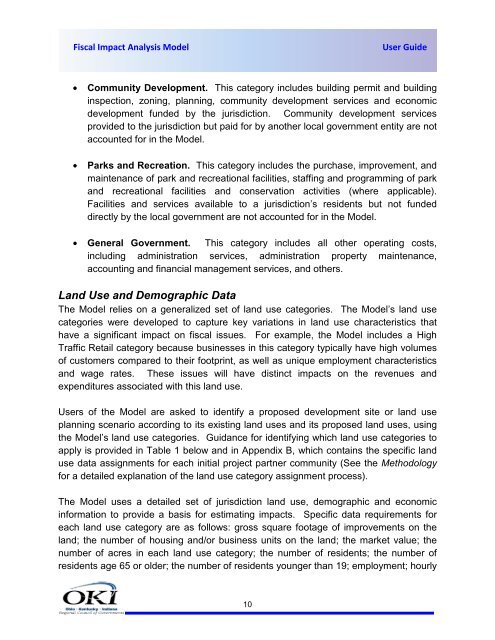FIAM USER GUIDE COVER II - Fiscal Impact Analysis Model - OKI
FIAM USER GUIDE COVER II - Fiscal Impact Analysis Model - OKI
FIAM USER GUIDE COVER II - Fiscal Impact Analysis Model - OKI
You also want an ePaper? Increase the reach of your titles
YUMPU automatically turns print PDFs into web optimized ePapers that Google loves.
<strong>Fiscal</strong> <strong>Impact</strong> <strong>Analysis</strong> <strong>Model</strong><br />
User Guide<br />
• Community Development. This category includes building permit and building<br />
inspection, zoning, planning, community development services and economic<br />
development funded by the jurisdiction. Community development services<br />
provided to the jurisdiction but paid for by another local government entity are not<br />
accounted for in the <strong>Model</strong>.<br />
• Parks and Recreation. This category includes the purchase, improvement, and<br />
maintenance of park and recreational facilities, staffing and programming of park<br />
and recreational facilities and conservation activities (where applicable).<br />
Facilities and services available to a jurisdiction’s residents but not funded<br />
directly by the local government are not accounted for in the <strong>Model</strong>.<br />
• General Government. This category includes all other operating costs,<br />
including administration services, administration property maintenance,<br />
accounting and financial management services, and others.<br />
Land Use and Demographic Data<br />
The <strong>Model</strong> relies on a generalized set of land use categories. The <strong>Model</strong>’s land use<br />
categories were developed to capture key variations in land use characteristics that<br />
have a significant impact on fiscal issues. For example, the <strong>Model</strong> includes a High<br />
Traffic Retail category because businesses in this category typically have high volumes<br />
of customers compared to their footprint, as well as unique employment characteristics<br />
and wage rates. These issues will have distinct impacts on the revenues and<br />
expenditures associated with this land use.<br />
Users of the <strong>Model</strong> are asked to identify a proposed development site or land use<br />
planning scenario according to its existing land uses and its proposed land uses, using<br />
the <strong>Model</strong>’s land use categories. Guidance for identifying which land use categories to<br />
apply is provided in Table 1 below and in Appendix B, which contains the specific land<br />
use data assignments for each initial project partner community (See the Methodology<br />
for a detailed explanation of the land use category assignment process).<br />
The <strong>Model</strong> uses a detailed set of jurisdiction land use, demographic and economic<br />
information to provide a basis for estimating impacts. Specific data requirements for<br />
each land use category are as follows: gross square footage of improvements on the<br />
land; the number of housing and/or business units on the land; the market value; the<br />
number of acres in each land use category; the number of residents; the number of<br />
residents age 65 or older; the number of residents younger than 19; employment; hourly<br />
10
















